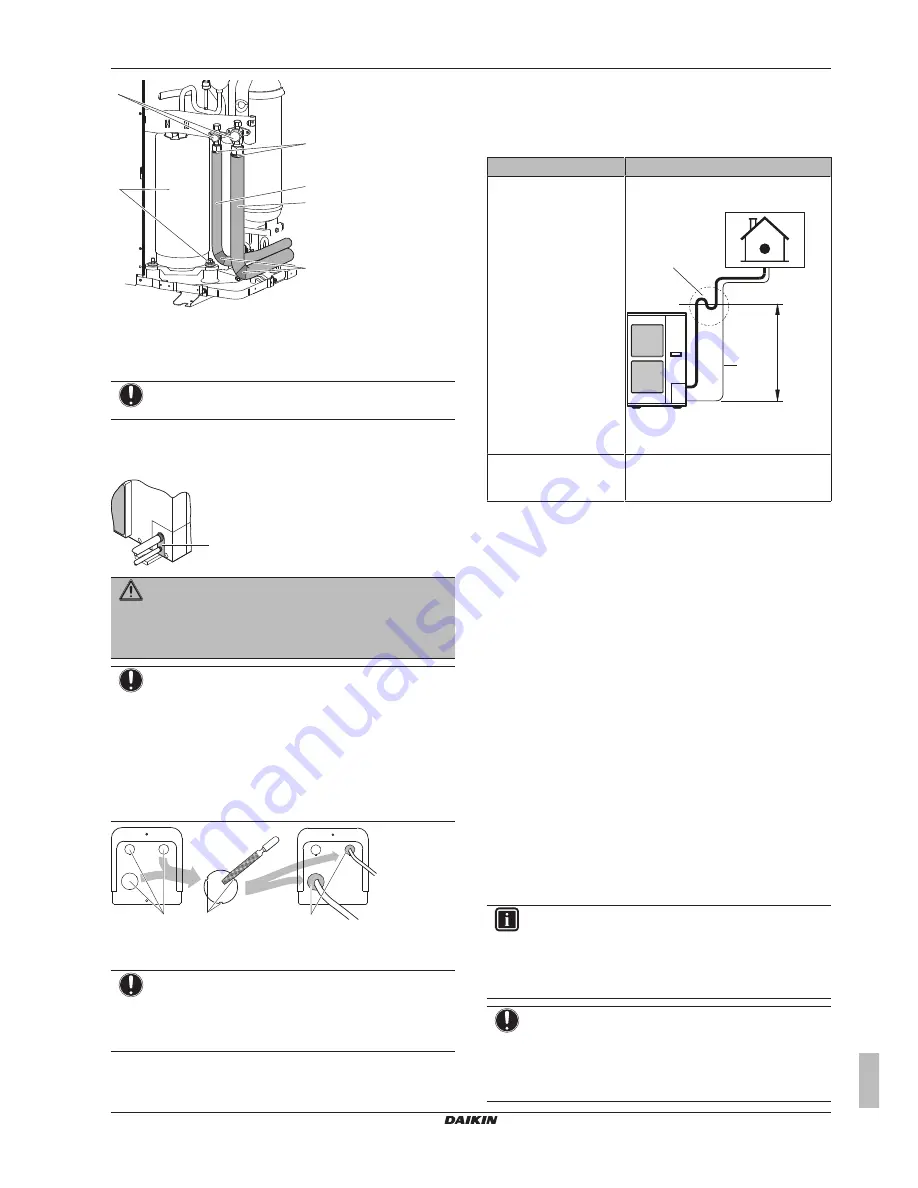
6 Installation
Installer reference guide
17
RZQG71~Y1 + RZQSG100~Y1
Split system air conditioners
4P385522-1A – 2016.10
d
e
f
b
a
c
6
If the outdoor unit is installed above the indoor unit, cover the
stop valves (f, see above) with sealing material to prevent
condensed water on the stop valves from moving to the indoor
unit.
NOTICE
Any exposed piping might cause condensation.
7
Reattach the service cover and the piping intake plate.
8
Seal all gaps (example: a) to prevent snow and small animals
from entering the system.
a
WARNING
Provide adequate measures to prevent that the unit can be
used as a shelter by small animals. Small animals that
make contact with electrical parts can cause malfunctions,
smoke or fire.
NOTICE
Precautions when making knockout holes:
▪ Avoid damaging the casing.
▪ After making the knockout holes, we recommend you
remove the burrs and paint the edges and areas
around the edges using repair paint to prevent rusting.
▪ When passing electrical wiring through the knockout
holes, wrap the wiring with protective tape to prevent
damage.
b
c
a
a
Knockout hole
b
Burr
c
Sealant etc.
NOTICE
Make sure to open the stop valves after installing the
refrigerant piping and performing vacuum drying. Running
the system with the stop valves closed may break the
compressor.
6.4.9
To determine if oil traps are required
If oil flows back into the outdoor unit's compressor, this might cause
liquid compression or deterioration of oil return. Oil traps in the rising
gas piping can prevent this.
If
Then
The indoor unit is installed
higher than the outdoor
unit
Install an oil trap every 10 m (height
difference).
a
b
10 m
a
Rising gas piping with oil trap
b
Liquid piping
The outdoor unit is
installed higher than the
indoor unit
Oil traps are NOT required.
6.5
Checking the refrigerant piping
6.5.1
About checking the refrigerant piping
The outdoor unit's
internal
refrigerant piping has been factory tested
for leaks. You only have to check the outdoor unit's
external
refrigerant piping.
Before checking the refrigerant piping
Make sure the refrigerant piping is connected between the outdoor
unit and the indoor unit.
Typical workflow
Checking the refrigerant piping typically consists of the following
stages:
1
Checking for leaks in the refrigerant piping.
2
Performing vacuum drying to remove all moisture, air or
nitrogen from the refrigerant piping.
If there is a possibility of moisture being present in the refrigerant
piping (for example, water may have entered the piping), first carry
out the vacuum drying procedure below until all moisture has been
removed.
6.5.2
Precautions when checking the
refrigerant piping
INFORMATION
Also read the precautions and requirements in the
following chapters:
▪ General safety precautions
▪ Preparation
NOTICE
Use a 2-stage vacuum pump with a non-return valve that
can evacuate to a gauge pressure of −100.7 kPa
(−1.007 bar)(5 Torr absolute). Make sure the pump oil
does not flow oppositely into the system while the pump is
not working.
















































